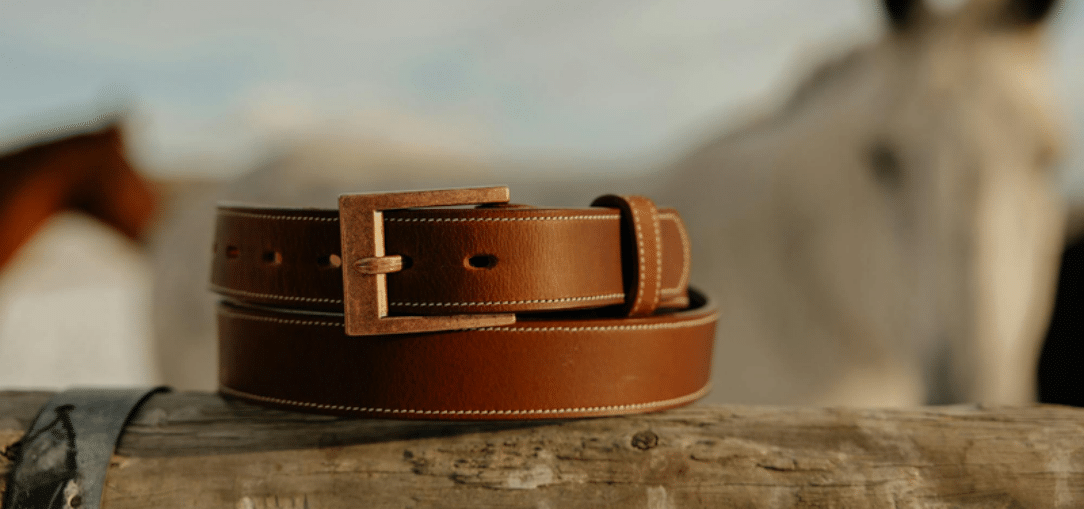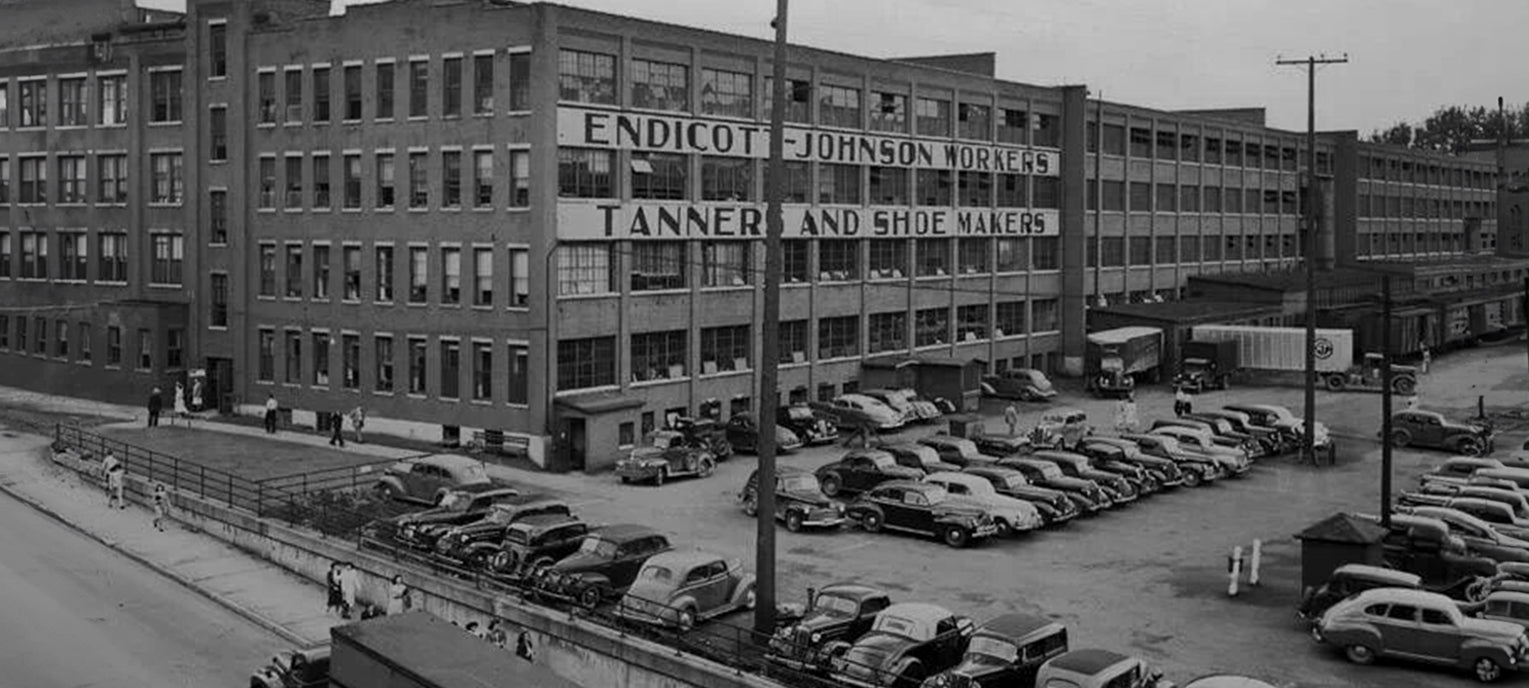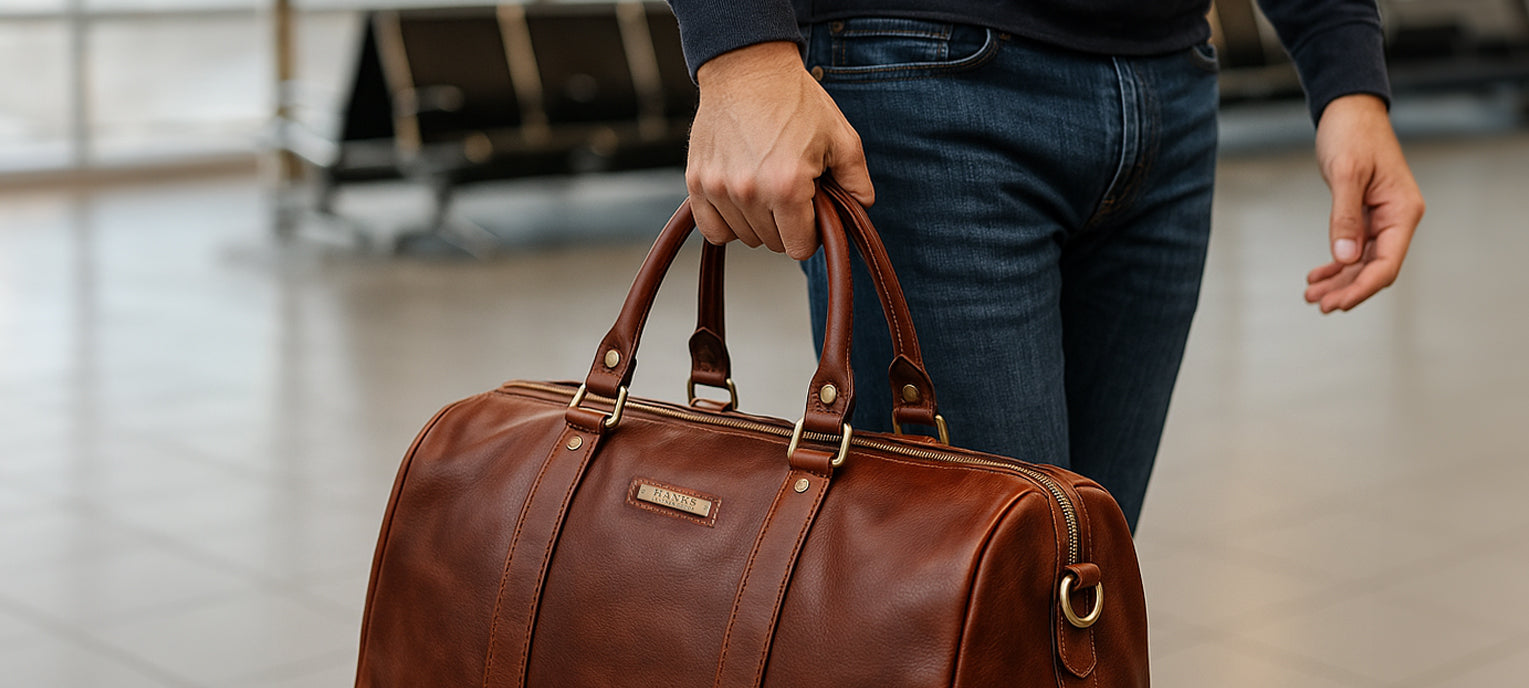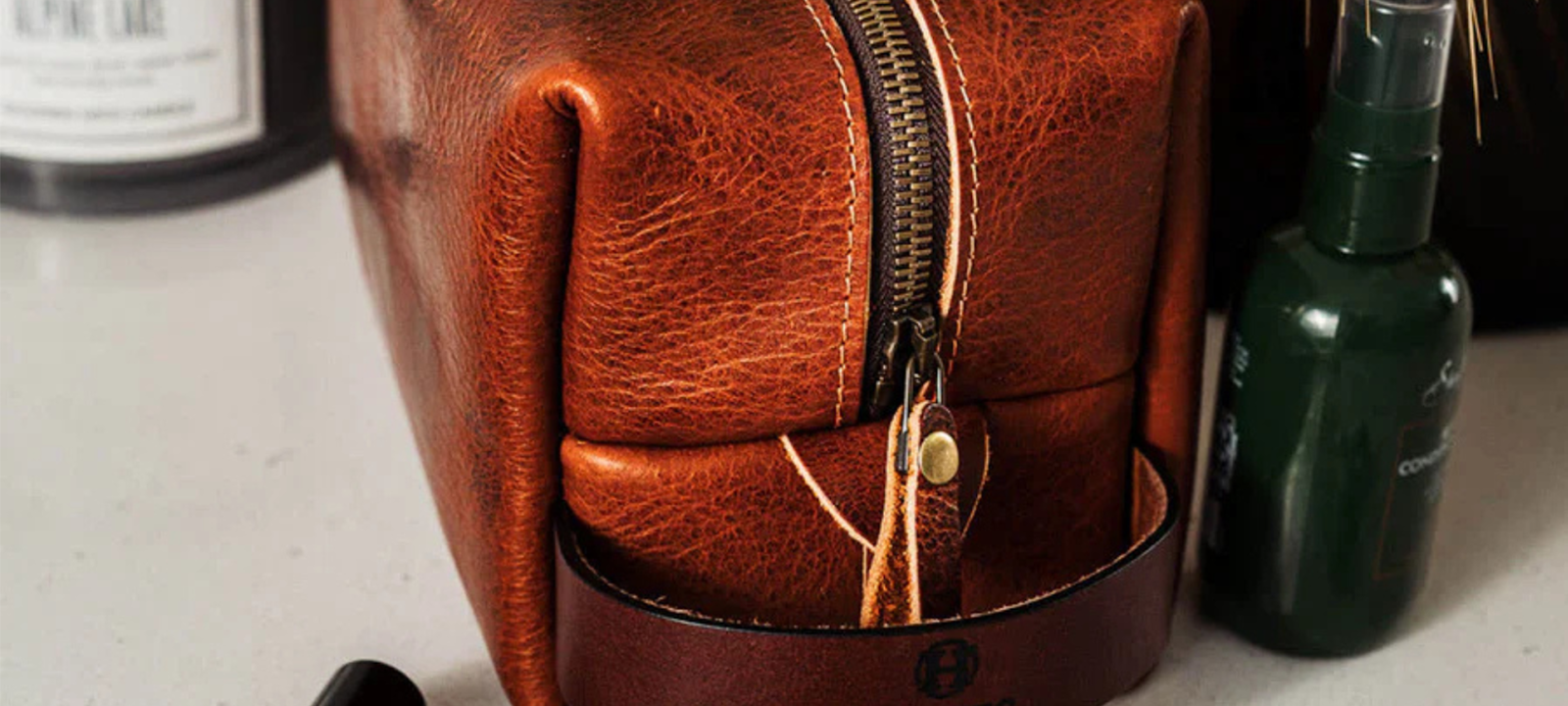Key Takeaways:
- Know Your Buckles: The right belt buckle complements your style and needs. From classic frame-style buckles to modern automatic designs, understanding your options ensures a perfect match.
- Pairing Matters: Selecting the right belt for your buckle means considering craftsmanship, durability, and personal style. A well-chosen combination enhances both function and appearance.
- Master the Fit: Fastening a belt buckle is a skill that blends precision with craftsmanship. Following our step-by-step approach ensures a secure, polished look that boasts American-made quality.
Buckle up for a lesson in craftsmanship and tradition, because a belt is more than an accessory—it embodies rugged durability, refinement, and the mark of a well-dressed individual. For over three generations, Hanks Leather Goods has perfected the art of crafting belts that stand the test of time, blending rugged strength with classic style.
Whether you're attaching a belt buckle for the first time or making sure it fits just right, this guide will take you through the simple yet important steps of securing a buckle to your belt. More than just a practical task, it's a small but meaningful way to appreciate the craftsmanship of American-made quality.
Understanding Different Types Of Belt Buckles
A well-crafted belt buckle defines your style, adding character, sophistication, and purpose to your outfit. Whether you're stepping into a boardroom, attending a formal dinner, or meeting friends for a night out, the right choice defines your look. Every detail matters, and a thoughtfully selected buckle enhances your stylish allure. Now, let’s explore the different types of belt buckles and how each complements your style.
Frame-Style Buckles: A Classic For Any Occasion
Frame-style buckles embody timeless elegance and versatility, making them a staple in both casual and formal wardrobes. Featuring a simple yet refined frame through which the belt strap passes, this buckle type complements everything from tailored suits to rugged denim and button-downs.
A frame-style buckle pairs seamlessly with polished leather dress shoes in a business setting or with worn-in boots for a laid-back, rugged aesthetic. At Hanks, our USA-made belts with frame-style buckles are crafted to endure, developing a rich patina that deepens with time, reflecting the wearer’s character.
Plate Buckles: A Statement Of Bold Individuality
A plate buckle embodies craftsmanship and personal expression, making it a standout choice for those who appreciate intricate details. Featuring an engraved or embossed front plate, these buckles often display designs, logos, or commemorative emblems that add character to any outfit. Whether showcasing a rodeo-inspired motif, a heritage emblem, or a custom-engraved design, plate buckles bring a level of artistry that sets them apart.
The bold aesthetic makes them a natural fit for Western-inspired fashion, rugged workwear, and vintage Americana looks. These buckles thrive in outfits that embrace durability and authenticity, making them a favorite among ranchers and craftsmen.
Box Frame Buckles: A Sleek And Modern Edge
Box frame buckles offer a clean, minimalist aesthetic that suits contemporary fashion. Unlike traditional pronged designs, this buckle secures the belt using a box-like frame and friction, creating a seamless, polished look.
The structured silhouette complements modern business attire, monochromatic outfits, and sleek streetwear. A black leather belt with a box frame buckle enhances the sharpness of a tailored blazer, while a brown leather option pairs well with a structured wool coat for understated sophistication.
O-Ring And D-Ring Buckles: Effortless Casual Style
O-Ring and D-Ring buckles introduce a relaxed, utilitarian touch to any wardrobe. These buckles use one or two metal rings to secure the belt through threading, allowing for a fully adjustable fit.
Ideal for casual and outdoor settings, these buckles complement workwear-inspired looks, coastal summer attire, and woven fabric belts. A canvas belt with an O-Ring buckle pairs effortlessly with cargo pants and a lightweight linen shirt, while a leather D-Ring buckle adds a subtle rugged edge to a flannel-and-denim combination.
Automatic Buckles: Precision And Convenience In Motion
Automatic buckles deliver a sleek and modern fastening system–perfect for those who value precision. The ratcheting mechanism allows for micro-adjustments, ensuring a flawless fit every time.
Perfectly suited for business professionals, high-end fashion enthusiasts, and those who appreciate fine tailoring, this buckle pairs well with slim-fit suits, structured outerwear, and polished dress shoes. Likewise, a dark leather belt with an automatic buckle refines a tailored look, while a contemporary design in a muted tone adds a modern touch to a casual ensemble.
Choosing The Right Belt For Your Buckle
A buckle may be the focal point of a belt, but the leather that supports it plays an equally important role. A well-paired belt ensures both durability and style, enhancing the overall look while securing a comfortable fit. At Hanks Leather Goods, every belt is designed with lasting quality in mind. Here’s how to select the perfect belt to complement your buckle.
- Built for Durability and Longevity: A high-quality belt should offer durability that lasts for years, developing character with every wear. Hanks Leather Goods crafts each belt from full-grain leather, ensuring unmatched resilience and timeless appeal. More than just an accessory, these belts become heirlooms, carrying the stories of those who wear them.
- Matching Your Belt to Your Style: Choosing the right belt means finding one that not only suits your buckle but also aligns with your style. For example, our Antique Nickel Buckle pairs seamlessly with full-grain leather straps, offering a versatile look that balances rugged durability with a touch of vintage-inspired refinement.
- Understanding Leather Quality and Aging: Leather quality plays a crucial role in how a belt ages. Unlike mass-produced alternatives, full-grain leather belts soften over time, gaining a rich patina that tells a story of craftsmanship and wear. With proper care, a well-crafted belt only gets better with age, making it a lasting investment.
Step-By-Step Guide To Fastening A Classic Belt Buckle
A belt buckle isn’t just a functional piece—it’s a statement of craftsmanship and durability. Whether you're swapping out an old buckle for a new one or securing a classic frame-style design, knowing how to properly attach and fasten your belt buckle ensures both style and function. Follow these steps to attach a removable buckle and secure it with confidence.
1. Choose Your Belt And Buckle
Before you start, make sure your belt is compatible with interchangeable buckles. Most removable buckles work with belts that have snap closures or screw fastenings at the end. Hanks Leather Goods offers a rugged selection of belt buckles designed to last a lifetime, from distressed classic looks to minimalist designs.
2. Remove The Existing Buckle
If you're replacing a buckle, start by undoing the snaps, screws, or clasps at the belt’s end. Gently pull the buckle free from the leather strap, ensuring you don't damage the belt holes or fasteners. If your belt has screws, use a small screwdriver to loosen them before removing the old buckle.
3. Align The New Buckle With The Belt End
Before securing the buckle, ensure it’s properly positioned with the belt strap. The buckle frame or plate should sit flush against the attachment points, and if the design includes a prong, it should be facing outward, ready to lock into place.
For a frame-style buckle, slide the belt end through the metal loop and guide it until the prong aligns with the holes. A plate buckle requires hooking the belt onto the back of the buckle and pressing it firmly against the leather for a seamless fit. If you’re using a box frame buckle, feed the belt through the designated slot and engage the tension mechanism to hold it in place.
4. Secure The Buckle In Place
Now that your buckle is aligned, it’s time to lock it in place. The fastening method depends on the belt’s design:
- Snap-Closure Belts: Locate the two snaps at the end of the belt strap. Press them firmly until they click into place, securing the buckle tightly against the leather. Give the buckle a gentle tug to ensure it's properly attached.
- Screw-Fastened Belts: Use a small screwdriver to tighten the screws on either side of the belt’s attachment point. Turn each screw clockwise until they sit flush with the leather, holding the buckle securely in place. Double-check that the buckle doesn’t shift or loosen with movement.
- Hook-and-Loop Designs: If your belt uses a hook-and-loop system, slide the leather end into the slots at the back of the buckle. Check to see if the hooks latch onto the loops securely. A properly fastened hook-and-loop buckle should feel firm without slipping.
5. Fasten The Belt Through The Buckle
With the buckle securely attached, it’s time to thread your belt through your pant loops and lock it into position:
- For Pronged Buckles: Feed the loose end of the belt through the metal frame, guiding it toward the prong. Choose a hole that provides a snug yet comfortable fit, then press the prong down firmly into place. Make sure the belt sits evenly across your waist.
- For Automatic Buckles: Slide the belt’s end into the buckle until you hear the ratcheting mechanism engage. Keep threading it through until it feels secure, then pull slightly to test the hold. If needed, press the buckle’s release lever.
- For Plate Buckles: Hook the belt tip onto the metal clasp at the back of the plate buckle. Ensure the leather sits flush against the backplate before pressing it firmly into place. The belt should stay locked in with minimal movement.
Once fastened, tuck any excess belt length into the keeper loop or belt loops on your pants for a clean, polished finish.
6. Adjust and Tuck for a Polished Look
After fastening, check that the belt sits evenly around your waist. Tuck any excess length into the belt keeper or loops to ensure a clean, refined appearance. With the right buckle and a Hanks full-grain leather belt, you get more than just a way to hold up your pants—you secure a lifetime of rugged style and durability.
Common Mistakes When Putting On A Belt Buckle
Navigating the world of belt buckles can be surprisingly intricate. A properly secured buckle enhances not only the belt’s fit but also its overall aesthetic. Here are some common pitfalls to avoid when fastening your buckle:
- Improper Buckle Attachment: A loose or misaligned buckle can throw off your belt’s fit. Whether using snaps, screws, or a hook-and-loop design, ensure the buckle is properly secured to prevent shifting or discomfort.
- Choosing the Wrong Buckle Style: The buckle is a focal point, so selecting one that clashes with your outfit can disrupt your look. A polished frame-style buckle works well for formal wear, while a rugged plate buckle suits casual or work belts. Hanks Leather Goods offers a variety of buckle styles to match any wardrobe.
- Failing to Secure the Prong or Latch: A pronged buckle should be inserted into a belt hole that provides a snug fit. Automatic and plate buckles require proper alignment with the strap to stay secure.
- Neglecting Buckle Maintenance: Regularly wiping down the metal prevents tarnishing, and checking screws or clasps ensures they remain tight.
- Incorrectly Threading the Belt: Some buckles like box frames or ratchet styles require precise threading. Misalignment can cause discomfort or an insecure fit, so take a moment to ensure the belt feeds smoothly through the buckle.
Final Thoughts
Putting on a belt buckle with confidence and ease is about more than just functionality; it's a small but significant step in elevating your daily style. At Hanks Leather Goods, we know that every accessory reflects personal taste and a commitment to quality. Our belt buckles, crafted with precision and built to last, do more than secure your pants—they stand as a testament to craftsmanship you can trust every day.
Whether you're heading to work or enjoying a laid-back weekend, a well-made belt and buckle become trusted companions in your journey. As they age with time and age like a fine wine, they become an integral part of your story. When you choose Hanks Leather Goods, you invest in craftsmanship, tradition, and a belt designed to be with you for a lifetime.
Frequently Asked Questions About Putting On A Belt Buckle
What materials are belt buckles typically made from?
Belt buckles are commonly crafted from brass, nickel, stainless steel, and zinc alloy. Brass buckles naturally oxidize over time, which develops a subtle patina that enhances their vintage appeal. Alternatively, stainless steel buckles are highly resistant to rust and corrosion.
Hanks Leather Goods ensures that every buckle is built to complement their premium full-grain leather belts, combining rugged durability with classic style. Whether you prefer the timeworn character of a brass plate buckle or the refined gleam of a polished frame-style design, Hanks offers high-quality options that hold up to daily wear while maintaining their distinct aesthetic.
Do I need any tools to change a belt buckle?
All you need is a straight head screwdriver to change belt buckles. Hanks Leather Goods belts make the process seamless with their expertly crafted, user-friendly designs. Simply unscrew the two screws on the belt, remove the old buckle, and slide in the new one before screwing it back into place.
How do I remove an old belt buckle?
To remove an old belt buckle, start by unscrewing the belt at the buckle end. Next, slide the buckle off the belt. It's that simple! Hanks Leather Goods creates belts that prioritize ease of use while maintaining their rugged durability.
What direction should the buckle face?
The proper direction for the belt buckle is with the prong facing to your left side if you are wearing it yourself. This ensures that your belt fastens securely. With a Hanks belt, you can trust its traditional craftsmanship for a comfortable and reliable fit.
Does the buckle have to match my other accessories?
While there's no hard rule, coordinating your belt buckle with other accessories, such as your watch or wallet, is aesthetically pleasing and stylish. Hanks Leather Goods offers belts that develop unique character and age gracefully, effortlessly complementing any ensemble.
How tight should the belt be when wearing a buckle?
Your belt should be snug enough to keep your pants secure without feeling restrictive. A proper fit allows for a slight movement while making sure the belt doesn’t shift throughout the day. If it’s too loose, the belt won’t provide the necessary support, and if it’s too tight, it can pinch your waist and cause discomfort. Ideally, you should be able to slide two fingers between the belt and your waist.
What do I do if my belt is too long for the buckle?
If your belt is too long, consider visiting a professional to shorten it, ensuring it retains its quality and fit. Alternatively, many users find folding the excess length back through the loops helpful. With Hanks' focus on outstanding craftsmanship, you'll enjoy a belt tailored to last more than a lifetime.







